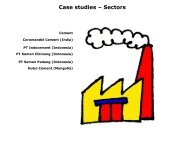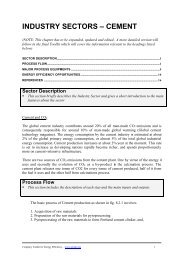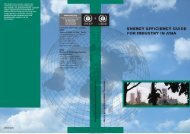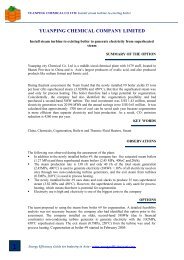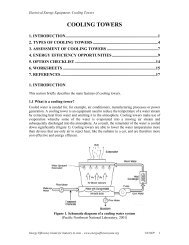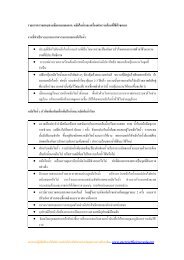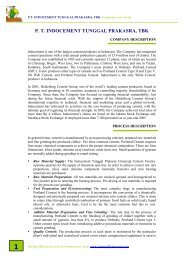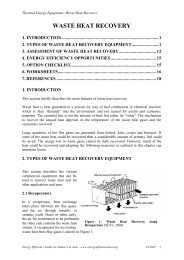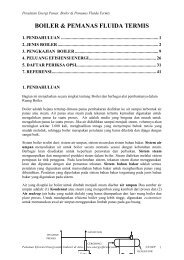Chapter - Fuels and Combustion - RETScreen International
Chapter - Fuels and Combustion - RETScreen International
Chapter - Fuels and Combustion - RETScreen International
Create successful ePaper yourself
Turn your PDF publications into a flip-book with our unique Google optimized e-Paper software.
Thermal Equipment: <strong>Fuels</strong> <strong>and</strong> <strong>Combustion</strong><br />
The ultimate analysis indicates the various elemental chemical constituents such as carbon,<br />
hydrogen, oxygen, sulphur, etc. It is useful in determining the quantity of air required for<br />
combustion <strong>and</strong> the volume <strong>and</strong> composition of the combustion gases. This information is<br />
required for the calculation of flame temperature <strong>and</strong> the flue duct design etc. Typical<br />
ultimate analyses of various coals are given in the table below.<br />
Table 7. Typical ultimate analysis of coals<br />
Parameter Indian Coal, % Indonesian Coal, %<br />
Moisture 5.98 9.43<br />
Mineral Matter (1.1 x Ash) 38.63 13.99<br />
Carbon 41.11 58.96<br />
Hydrogen 2.76 4.16<br />
Nitrogen 1.22 1.02<br />
Sulphur 0.41 0.56<br />
Oxygen 9.89 11.88<br />
Table 8. Relationship between ultimate analysis <strong>and</strong> proximate analysis<br />
%C = 0.97C+ 0.7(VM - 0.1A) - M(0.6-0.01M)<br />
%H =<br />
0.036C + 0.086 (VM -0.1xA) - 0.0035M 2 (1-0.02M)<br />
%N<br />
2<br />
= 2.10 -0.020 VM<br />
Where<br />
C = % of fixed carbon<br />
A = % of ash<br />
VM = % of volatile matter<br />
M = % of moisture<br />
Note: the above equation is valid for coal with a greater than 15% moisture content<br />
2.2.4 Storage, h<strong>and</strong>ling <strong>and</strong> preparation of coal<br />
Uncertainty in the availability <strong>and</strong> transportation of fuel necessitates storage <strong>and</strong> subsequent<br />
h<strong>and</strong>ling. Storing coal has its own disadvantages like build-up of inventory, space constraints,<br />
deterioration in quality <strong>and</strong> potential fire hazards. Other minor losses associated with the<br />
storage of coal include oxidation, wind <strong>and</strong> carpet loss. A 1% oxidation of coal has the same<br />
effect as 1% ash in coal. Wind losses may account for nearly 0.5 –1.0 % of the total loss.<br />
The main goal of good coal storage is to minimize carpet loss <strong>and</strong> the loss due to spontaneous<br />
combustion. Formation of a soft carpet, comprising of coal dust <strong>and</strong> soil, causes carpet loss.<br />
On the other h<strong>and</strong>, if the temperature gradually rises in a coal heap, then oxidation may lead<br />
to spontaneous combustion of coal stored. Carpet losses can be reduced by:<br />
1. Preparing a hard solid surface for coal to be stored<br />
2. Preparing st<strong>and</strong>ard storage bays of concrete <strong>and</strong> brick<br />
In industry, coal h<strong>and</strong>ling methods range from manual <strong>and</strong> conveyor systems. It would be<br />
advisable to minimize the h<strong>and</strong>ling of coal so that further generation of fines <strong>and</strong> segregation<br />
effects are reduced.<br />
Energy Efficiency Guide for Industry in Asia – www.energyefficiencyasia.org ©UNEP 8



